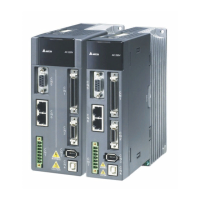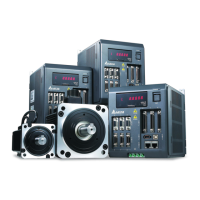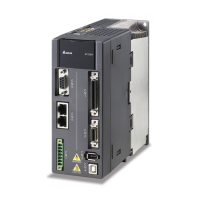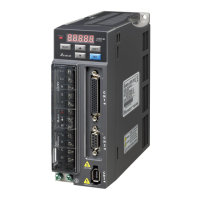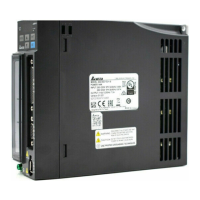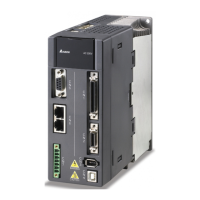Application Examples ASDA Series Application Note
3-16 March, 2015
Rising-edge Trigger EV1
When the system returns to the origin and after the first time EV1 is triggered by rising-edge, the
starting point is A instead of B. From the second time, it will start from point B because it is set to
absolute position in the PR path. First of all, set the torque force to 25% before issuing the
position command. This is because there will be a bigger striction when motor is started; if torque
force is set too small, the motor will not move or move only for a short while and then stop. Once
the motor is started successfully, kinetic friction will be rather smaller. Then, use step 4 (PR#7) to
decrease the torque force to 10%. This step is for avoiding the round compression axis knocking
the rectangle carrier too hard. Then, the compression axis moves to point C but it is never able to
reach the target distance D (-800000) due to the obstruction of the rectangle carrier. In this case,
the setting value of P2-35 (Condition of Excessive Position Control Deviation Warning) must be
bigger than distance F; Otherwise, AL009 (Excessive Deviation of Position Command) might
occur. Based on the possible position of the rectangle carrier, distance F in Figure 3.1.18 is the
most possible maximum distance that the compression axis can travel. When compression axis
reaches position C and stops, this will be the timing for sampling. DI7 has to be switched ON to
enable the Capture function and record the position. Capture function will be explained later in
section 3.1.3.5.
Falling-edge Trigger EV1
After DI7 is On and sampling is complete, falling-edge trigger EV1 and raise the torque level. Let
the compression axis move back to position B. Then, wait for the rectangle carrier to move to the
next sampling position. Allow the system repeat the steps from 1 to 7.
3.1.3.5 Settings for Capture Function
The main purpose of using Capture function is to record the position of the round compression
axis. With this function, this value can be easily written to data array on ASDA-A2. Capture
function settings can be done either by directly setting parameter value or ASDA-Soft, which is
rather easier.
Using Capture Function by Directly Setting Parameter Value
P5-36 (CAPTURE-Start Address of Data Array): Set to 0.
P5-38 (CAPTURE-The Number of Capturing Times): Set to 50; 50 points on E-Cam curve have
to be captured.
P5-39 (CAPTUR-Activate CAP Control): Set to 0xF030 (0xUZYX).
X: 0 means Capture function is not enabled.
Y: 3 means Main ECN (main encoder); Position of the compression axis is based on the main
encoder.
Z: 0 stands for No. When DI7 is triggered, the system starts to sample on the rising-edge.
U: F stands for the shortest time interval. This is for preventing errors (For example, inputting
multiple values into the servo drive when pressing some buttons once.
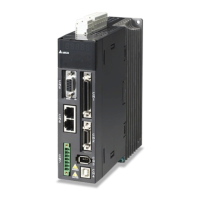
